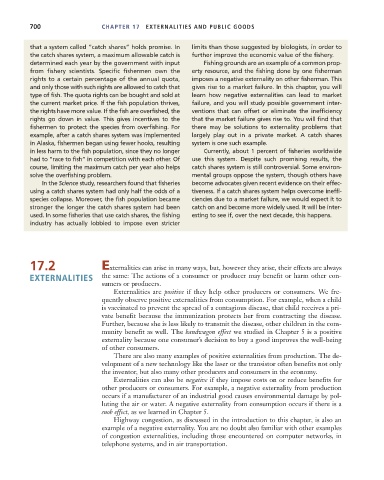Page 726 - Microeconomics, Fourth Edition
P. 726
c17ExternalitiesandPublicGoods.qxd 8/22/10 4:56 AM Page 700
700 CHAPTER 17 EXTERNALITIES AND PUBLIC GOODS
that a system called “catch shares” holds promise. In limits than those suggested by biologists, in order to
the catch shares system, a maximum allowable catch is further improve the economic value of the fishery.
determined each year by the government with input Fishing grounds are an example of a common prop-
from fishery scientists. Specific fishermen own the erty resource, and the fishing done by one fisherman
rights to a certain percentage of the annual quota, imposes a negative externality on other fisherman. This
and only those with such rights are allowed to catch that gives rise to a market failure. In this chapter, you will
type of fish. The quota rights can be bought and sold at learn how negative externalities can lead to market
the current market price. If the fish population thrives, failure, and you will study possible government inter-
the rights have more value. If the fish are overfished, the ventions that can offset or eliminate the inefficiency
rights go down in value. This gives incentives to the that the market failure gives rise to. You will find that
fishermen to protect the species from overfishing. For there may be solutions to externality problems that
example, after a catch shares system was implemented largely play out in a private market. A catch shares
in Alaska, fishermen began using fewer hooks, resulting system is one such example.
in less harm to the fish population, since they no longer Currently, about 1 percent of fisheries worldwide
had to “race to fish” in competition with each other. Of use this system. Despite such promising results, the
course, limiting the maximum catch per year also helps catch shares system is still controversial. Some environ-
solve the overfishing problem. mental groups oppose the system, though others have
In the Science study, researchers found that fisheries become advocates given recent evidence on their effec-
using a catch shares system had only half the odds of a tiveness. If a catch shares system helps overcome ineffi-
species collapse. Moreover, the fish population became ciencies due to a market failure, we would expect it to
stronger the longer the catch shares system had been catch on and become more widely used. It will be inter-
used. In some fisheries that use catch shares, the fishing esting to see if, over the next decade, this happens.
industry has actually lobbied to impose even stricter
17.2 Externalities can arise in many ways, but, however they arise, their effects are always
EXTERNALITIES the same: The actions of a consumer or producer may benefit or harm other con-
sumers or producers.
Externalities are positive if they help other producers or consumers. We fre-
quently observe positive externalities from consumption. For example, when a child
is vaccinated to prevent the spread of a contagious disease, that child receives a pri-
vate benefit because the immunization protects her from contracting the disease.
Further, because she is less likely to transmit the disease, other children in the com-
munity benefit as well. The bandwagon effect we studied in Chapter 5 is a positive
externality because one consumer’s decision to buy a good improves the well-being
of other consumers.
There are also many examples of positive externalities from production. The de-
velopment of a new technology like the laser or the transistor often benefits not only
the inventor, but also many other producers and consumers in the economy.
Externalities can also be negative if they impose costs on or reduce benefits for
other producers or consumers. For example, a negative externality from production
occurs if a manufacturer of an industrial good causes environmental damage by pol-
luting the air or water. A negative externality from consumption occurs if there is a
snob effect, as we learned in Chapter 5.
Highway congestion, as discussed in the introduction to this chapter, is also an
example of a negative externality. You are no doubt also familiar with other examples
of congestion externalities, including those encountered on computer networks, in
telephone systems, and in air transportation.

